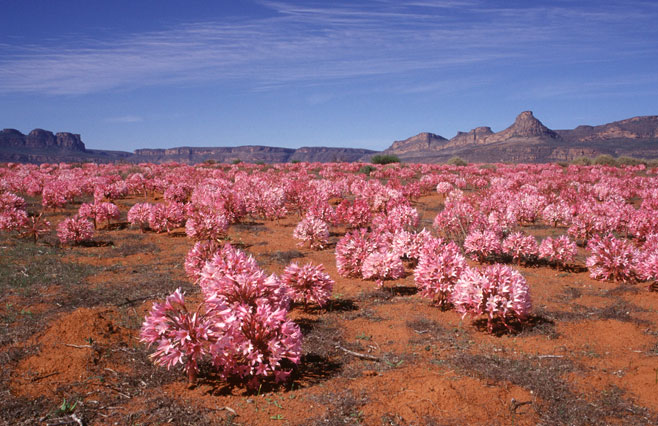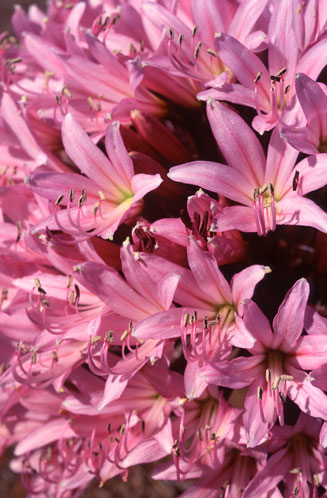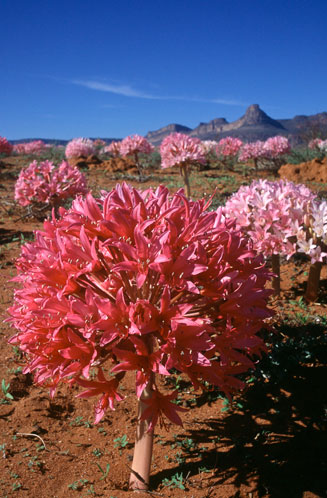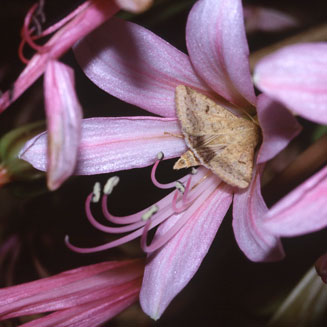Brunsvigia bosmaniae
Life
> eukaryotes >
Archaeoplastida >
Chloroplastida
>
Charophyta > Streptophytina > Plantae (land plants)
> Tracheophyta (vascular plants) > Euphyllophyta > Lignophyta (woody plants)
> Spermatophyta (seed plants) > Angiospermae (flowering
plants)
> Monocotyledons > Order:
Asparagales
> Family: Amaryllidaceae > Genus:
Brunsvigia
 |
|
Brunsvigia bosmaniae, flowering en masse
after good autumn rains on the Knersvlakte, Namaqualand, Northern Cape,
South Africa. [photo
Colin Paterson-Jones ©] |
 |
|
Brunsvigia bosmaniae, flowering on the
Knersvlakte with autumn rain on the Bokkeveld Escarpment, Namaqualand,
Northern Cape, South Africa. [photo
Colin Paterson-Jones ©] |
 |
 |
|
Brunsvigia bosmaniae, flowering in autumn
on the Bokkeveld Escarpment, Northern Cape, South Africa. [photo
Colin Paterson-Jones ©] |
Brunsvigia bosmaniae, flowering en masse after
good autumn rains on the Knersvlakte, Namaqualand, Northern Cape, South
Africa. [photo
Colin Paterson-Jones ©] |
Distribution and habitat
Occurs in Namaqualand and the Western Karoo
with the distribution extending as far south as Tygerberg (near Cape
Town). Thus the distribution includes parts of the Northern Cape and
Western Cape in South Africa. Grows in sand or clay as well as in
granite-derived soils (Goldblatt and Manning 2000).
Life cycle
- Bulbs are 5-10 cm in diameter.
- There are 5-6 leaves, pressed to the ground. The leaves are
absent at the time of flowering.
- Flowers in autumn, from March to May.
- The flowers grow in a large, round umbel and have the scent
of narcissus.
- Flowers are pollinated by noctuid moths (see image below).
- The seeds develop in three-angled capsules. Seed dispersal
is by wind: the ball-like umbel dries out, it is broken off by
the wind at the base of the scape (the stem of the flower head)
and the wind rolls it along the ground, with seeds becoming
dislodged from the capsules and falling to the ground.
- As flowers come out in Autumn, and this plant grows in a
winter rainfall region, by the time seed dispersal occurs it is
winter time and there is usually some moisture in the soil, or
rainfall is imminent, and thus the seeds are able to germinate.
Ecological interactions
 |
|
| The African Boll Worm moth (Helicoverpa
armigera), visiting flowers of Brunsvigia bosmaniae.
Bokkeveld Escarpment, Northern Cape, South Africa. [photo
Colin Paterson-Jones ©] |
|
Flowers are pollinated by:
- Insects > Lepidoptera > Noctuidae (noctuid moths)
- Helicoverpa armigera (African boll worm moth)
Links
|
